
A big pot of cocido, simmering last week in the Mexico Cooks! kitchen.
Nearly 40 years ago, long before the website Mexico Cooks! was a possibility–when I was just beginning to learn Spanish and some simple things about the totally-new-to-me Mexican kitchen, I would occasionally hear the word cocido from friends in Tijuana. I looked it up in my dictionary. I learned that cocido was the past participle for the verb cocer, to cook, or to boil. The dictionary gave this example: "Estoy a dieta, solo puedo comer pollo cocido." (I'm on a diet, I can only eat cooked [boiled] chicken.) OK! That was easy. But no, cocido isn't chicken. Back to the drawing board. For literally years I thought that cocido was a mystery dish that I would never see, understand, or taste.
About 20 years ago, I was looking at a homestyle restaurant menu and the lightbulb finally went on in my brain. I asked the waiter for a bowl of caldo de res (beef and vegetable soup), and he nodded as he wrote the order–and said, "Cocido para usted, señora." Wait! What? He smiled and said, Sí, cocido. O como dijo usted, caldo de res." ('Yes, 'cocido', or as you said"–well, you get it.) Like many things in Spanish, this is an example of their being more than one word for the same thing. Part of cultural literacy is learning what is colloquially used as a name for something that also has a more formal name.
Now that I knew what cocido is, I found someone to teach me how to make it, and today–if you don't know how already–I'm going to teach you. It's the simplest thing in the world, very healthy, and truly a Mexican home staple. An all-but-boiling bowlful is just the ticket for a warming meal in the winter, or conversely, a cooling meal when the weather is hot.
Cocido (Caldo de Res) from Michoacán
Ingredients
Medium white onion, coarsely chopped
1/2 head of garlic (sliced horizontally across the head, skin and all)
1 medium bay leaf
2-3 Tbsp sea salt
4-5 liters cold water
1 kilo (2.2 pounds) meaty, bone-in chambarete (beef shank), cut across the bone
1 kilo chuck meat, in large cubes
.5 kilo (1 pound) bone-in costilla de res (meaty beef ribs), cut into 2" to 3" pieces
3 or 4 medium carrots, peeled and cut into rounds
250gr green beans, ends removed and each bean cut or broken in half
3 or 4 large potatoes, peeled and cut into chunks or thick slices
1 middle-size chayote, cut into eighths, seed and all
1 small chile serrano, slit from tip almost to the stem end (optional)
4 small calabacitas (or zucchini), cut into thick slices
A quarter kilo (half pound) white cabbage, coarsely cut into chunks
A good-size fistful of cilantro, stems and all
5 or 6 sprigs of fresh hierbabuena (mint, and optional but you will love the flavor it adds)
2 or 3 ears of fresh corn, each ear cut into thirds (optional)
Special equipment
A 12-to-14 liter lidded pot
Long wooden spoon
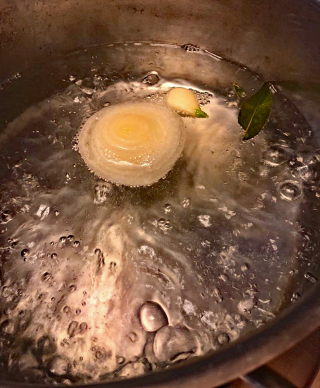
Bring 4 or 5 liters water, the onion, the half garlic head, the salt, and the bay leaf to a boil. Turn the heat down to a simmer. When the meat begins to produce foam on the surface of the water, scoop out and discard the foam. This will clarify your beef broth.
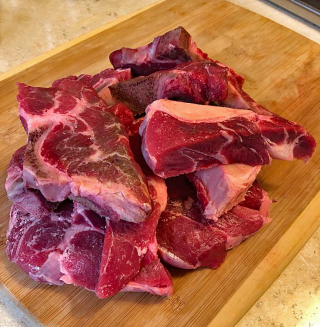
A portion of the beef and its trimmings, rinsed, patted dry, and ready to go in the pot.
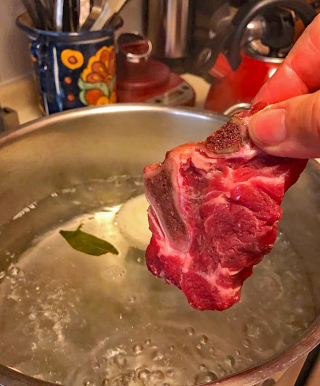
One piece at a time, quickly add the beef to the boiling water. In just a minute or two, the beef will take on a deep brown color. After skimming away the foam, allow the beef to simmer for about two hours.
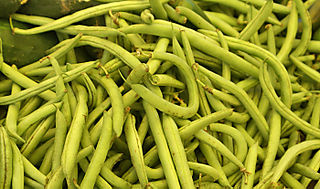
Remove the ends of the green beans and cut or break each one in half.

Carrots and calabacita (zucchini), ready to go in the pot.
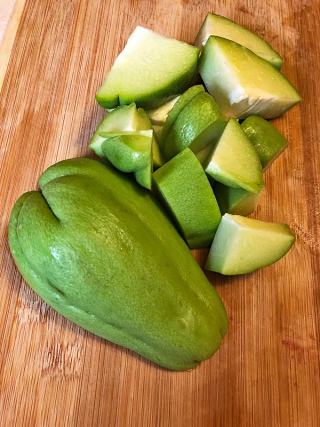
When you're ready to chop the chayote, try to pierce the skin with your fingernail. If it pierces easily, there's no need to peel the chayote, just chop it skin and all. The seed is flat, round, white and soft. The whitest part of the already cut chayote in the photograph is the seed–your knife will slide right through it, no need to remove it and cut it separately. Now, let's chop the other half of this chayote!

Coarsely chop the white cabbage, or leave it in narrow wedges, as in the photograph above.

Peel and cut up the potatoes. These are the standard white potato in Mexico: the papa Alfa. I started with three and added another. You can use a different kind of potato: russet, Yukon Gold, Red Bliss, whatever potato you prefer will be delicious.
For the tomato seasoning for the broth: put the coarsely chopped tomato, the 1/4 onion, a clove of garlic, and the chile serrano (if you're using it) into your blender. Add the 2 cups water. Cover and blend until smooth. Pour this mixture into the boiling pot.
Add all of the vegetables, including the cilantro, to the pot. Allow the pot to return just to a boil, then lower the heat to simmer and cover, leaving the cover slightly ajar. After 15 minutes cooking, stir the pot–the vegetables will have softened enough to be completely under water. Simmer for approximately 45 minutes.
Correct the salt to taste.
Prior to serving, remove the cilantro and the mint from the pot.
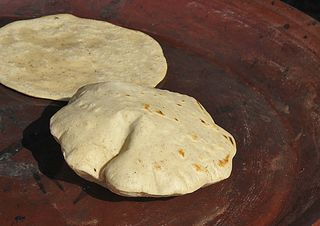
Freshly patted tortillas, toasting on a clay comal (griddle). They're supposed to inflate as they toast!
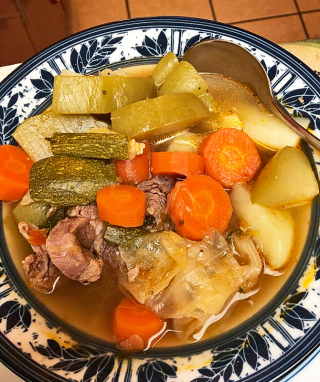
An all-but-overflowing bowlful of cocido. The house smelled delicious as it cooked, and the cocido itself was wonderful. And there's plenty left for the next few tomorrows!
Serve with limón (Key limes) to squeeze into the broth, hot tortillas, with corn tostadas, or with toasted bolillos (white flour, super-dense Mexican rolls).
Serves 6 to 8 as a main dish.
Looking for a tailored-to-your-interests specialized tour in Mexico? Click here: Tours.
Leave a Reply